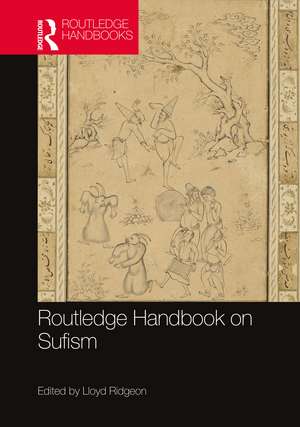Routledge Handbook on Sufism
Editat de Lloyd Ridgeonen Limba Engleză Hardback – 10 aug 2020
The volume outlines the origins and early developments of Sufism by assessing the formative thinkers and practitioners and investigating specific pietistic themes. The middle period contains an examination of the emergence of the Sufi Orders and illustrates the diversity of the tradition. This middle period also analyses the fate of Sufism during the time of the Gunpowder Empires. Finally, the end period includes representative surveys of Sufism in several countries, both in the West and in traditional "Islamic" regions.
This comprehensive and up-to-date collection of studies provides a guide to the Sufi tradition. The Handbook is a valuable resource for students and researchers with an interest in religion, Islamic Studies and Middle Eastern Studies.
| Toate formatele și edițiile | Preț | Express |
|---|---|---|
| Paperback (1) | 296.35 lei 3-5 săpt. | +22.67 lei 5-11 zile |
| Taylor & Francis – 9 ian 2023 | 296.35 lei 3-5 săpt. | +22.67 lei 5-11 zile |
| Hardback (1) | 1566.64 lei 6-8 săpt. | |
| Taylor & Francis – 10 aug 2020 | 1566.64 lei 6-8 săpt. |
Preț: 1566.64 lei
Preț vechi: 1910.54 lei
-18% Nou
Puncte Express: 2350
Preț estimativ în valută:
299.82€ • 311.85$ • 247.51£
299.82€ • 311.85$ • 247.51£
Carte tipărită la comandă
Livrare economică 14-28 aprilie
Preluare comenzi: 021 569.72.76
Specificații
ISBN-13: 9781138040120
ISBN-10: 1138040126
Pagini: 564
Ilustrații: 17 Halftones, black and white; 1 Tables, black and white; 18 Illustrations, black and white
Dimensiuni: 174 x 246 x 39 mm
Greutate: 1.08 kg
Ediția:1
Editura: Taylor & Francis
Colecția Routledge
Locul publicării:Oxford, United Kingdom
ISBN-10: 1138040126
Pagini: 564
Ilustrații: 17 Halftones, black and white; 1 Tables, black and white; 18 Illustrations, black and white
Dimensiuni: 174 x 246 x 39 mm
Greutate: 1.08 kg
Ediția:1
Editura: Taylor & Francis
Colecția Routledge
Locul publicării:Oxford, United Kingdom
Public țintă
PostgraduateCuprins
Transliteration Preface PART I: THE EARLY PERIOD 1. The Origins of Sufism Lloyd Ridgeon 2. al-Ḥārith al-Muḥāsibī and Spiritual Purification between Asceticism and Mysticism Gavin Picken 3. al-Junayd al-Baghdādī: Chief of the Sect Erik S. Ohlander 4. Abū Yazīd al-Bisṭāmī and Discussions about Intoxicated Sufism Annabel Keeler 5. Al-Ghazālī: In Praise of Sufism Carole Hillenbrand 6. ‘Ayn al-Quḍāt’s
Qur’ānic Vision: From Black Words to White Parchment Mohammed Rustom 7. Ibn ‘Arabī and the Akbarī Tradition Jawad Qureshi 8. Jalāl al-Dīn Rūmī and his Place in the History of Sufism Ibrahim Gamard 9. Opposition to Sufis in the Formative Period Harith Ramli 10. Narrativizing Early Mystic and Sufi Women Sara Abdel-Latif 11. Sufism and Travelling Arin Salamah-Qudsi 12. Sufism and Qur’ānic Ethics Atif Khalil 13. Love and Beauty in Sufism Joseph Lumbard 14. Sufism in Classical Persian Poetry Ali-Asghar Seyed-Gohrab PART II: THE MIDDLE PERIOD 15. Sufi Orders in the Medieval Period Lloyd Ridgeon 16. The Bektaşiyya Riza Yildirim 17. The Chishtiyya Scott Kugle 18. The Qalandariyya Katherine Pratt Ewing and Ilona Gerbakher 19. The Shādhiliyya Lahouari Ramzi Taleb 20. Sufism, Tombs and Convents Thierry Zarcone 21. Clothing and Investiture in Medieval Sufism Eyad Abuali 22. Sufism and Christian Mysticism Saeed Zarrabi-Zadeh 23. The Jewish-Sufi Encounter in the Middle Ages Elisha Russ-Fishbane 24. Sufism and the Hindu dharma Thomas Därnhardt 25. Sufism and the Safavids of Iran Andrew Newman 26. Sufism and the Mughals of India Kashshaf Ghani 27. Sufism in the Ottoman Empire John J. Curry 28. The Qāḍīzādelis and Sufism Mustapha Sheikh PART III: THE MODERN PERIOD 29. Sufism in Modern Turkey Kim Shively 30. Sufism in the UK Ron Geaves 31. Sufism and Vernacular Knowledge in Sindh Michel Boivin 32. A SUFISM FOR OUR TIME: THE EGYPTIAN SOCIETY FOR SPIRITUAL AND CULTURAL RESEARCH Valerie J. Hoffman 33. Sufism in Modern Morocco Marta Dominguez Diaz 34. Sufism in Senegal John Glover 35. Sufism in North America Juliane Hammer
Qur’ānic Vision: From Black Words to White Parchment Mohammed Rustom 7. Ibn ‘Arabī and the Akbarī Tradition Jawad Qureshi 8. Jalāl al-Dīn Rūmī and his Place in the History of Sufism Ibrahim Gamard 9. Opposition to Sufis in the Formative Period Harith Ramli 10. Narrativizing Early Mystic and Sufi Women Sara Abdel-Latif 11. Sufism and Travelling Arin Salamah-Qudsi 12. Sufism and Qur’ānic Ethics Atif Khalil 13. Love and Beauty in Sufism Joseph Lumbard 14. Sufism in Classical Persian Poetry Ali-Asghar Seyed-Gohrab PART II: THE MIDDLE PERIOD 15. Sufi Orders in the Medieval Period Lloyd Ridgeon 16. The Bektaşiyya Riza Yildirim 17. The Chishtiyya Scott Kugle 18. The Qalandariyya Katherine Pratt Ewing and Ilona Gerbakher 19. The Shādhiliyya Lahouari Ramzi Taleb 20. Sufism, Tombs and Convents Thierry Zarcone 21. Clothing and Investiture in Medieval Sufism Eyad Abuali 22. Sufism and Christian Mysticism Saeed Zarrabi-Zadeh 23. The Jewish-Sufi Encounter in the Middle Ages Elisha Russ-Fishbane 24. Sufism and the Hindu dharma Thomas Därnhardt 25. Sufism and the Safavids of Iran Andrew Newman 26. Sufism and the Mughals of India Kashshaf Ghani 27. Sufism in the Ottoman Empire John J. Curry 28. The Qāḍīzādelis and Sufism Mustapha Sheikh PART III: THE MODERN PERIOD 29. Sufism in Modern Turkey Kim Shively 30. Sufism in the UK Ron Geaves 31. Sufism and Vernacular Knowledge in Sindh Michel Boivin 32. A SUFISM FOR OUR TIME: THE EGYPTIAN SOCIETY FOR SPIRITUAL AND CULTURAL RESEARCH Valerie J. Hoffman 33. Sufism in Modern Morocco Marta Dominguez Diaz 34. Sufism in Senegal John Glover 35. Sufism in North America Juliane Hammer
Notă biografică
Lloyd Ridgeon is reader in Islamic Studies at Glasgow University. His main research interests include Persianate Sufism and also Iranian history and modern Iranian culture. He has published extensively on areas including javānmardī, and he is currently writing a book on how the ḥijāb has been understood by modern Iranian seminarians.
Descriere
This is a chronological history of the Sufi tradition, divided in to three sections, early, middle and modern periods. The book comprises 35 independent chapters with easily identifiable themes and/or geographical threads, all written by recognised experts in the field.
